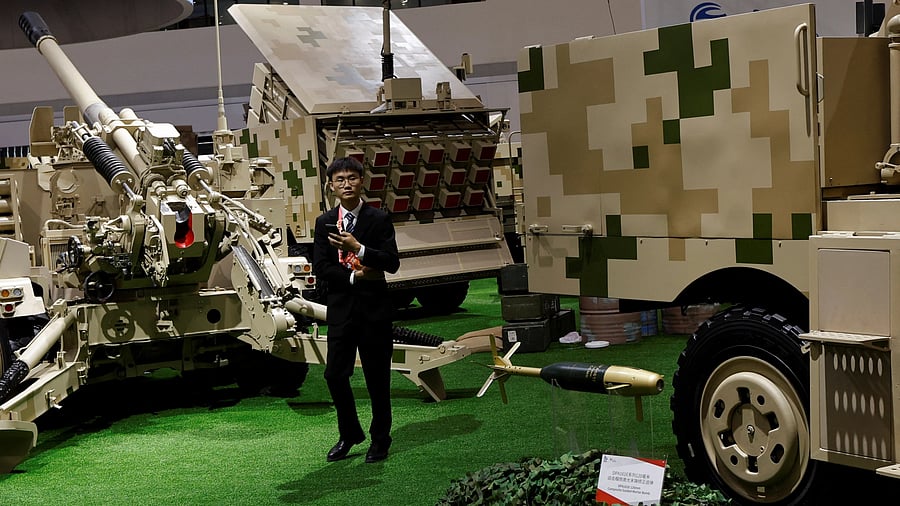
A man stands amid weapon displays at the Norinco booth during the China International Aviation and Aerospace Exhibition, or Airshow China, in Zhuhai, Guangdong province, China
Credit: Reuters photo
China has become the world’s fourth-largest arms exporter, commanding 5.8 per cent of global weapons sales between 2019 and 2023. While China slashed its own arms imports by 64 per cent over the past decade, it simultaneously expanded its weapons footprint to 44 countries across Asia, Africa, and Latin America.
Apart from geographic expanse, the strategic footprint achieved as part of China’s arms export strategy represents more than the mere logic of economics. Under Xi Jinping’s military modernisation agenda, weapons sales are integral to statecraft to create dependencies, secure allies, and challenge Western influence in key regions.
China’s strategic calculus behind the targeting of countries for arms sales and transfers coincides with the aspirations of making its military influence felt from the First Island Chain to the broader Indo-Pacific and beyond. China’s strategic influence spans and dominates across the Indo-Pacific. As emphasised by President Xi, the move is aimed at constructing “a common destiny of the Asia-Pacific”.
Between 2019-2023, 85 per cent of Chinese arms exports were concentrated in Asia. Pakistan, as an important all-weather ally, is a customer of China for 61-63 per cent of total exports. Bangladesh, Myanmar, and Thailand are secondary markets for small arms and ammunition. Bangladesh is currently the second-largest buyer of Chinese weapons in the region. China’s strategic rationale lies in building a regional sphere of influence, especially when India is steadily emerging as a competitor in the region.
China’s African expansion is in the sub-Saharan region, with 9.8 per cent of the total arms imports. It is overtaking Russia as a top supplier with a special focus on countries noted for weak governance and resource wealth. The weapons sale also seems to be integrated with the Belt and Road Initiative projects and military training programmes.
In the Middle East and North Africa (MENA), strategic penetration is limited in the Gulf states and Saudi Arabia, as there is competition between Chinese and Western players. China has also expanded its presence in Latin American countries such as Venezuela, Argentina, and Bolivia.
The Chinese arms sales model is based on three core factors. It prioritises generating profits as per foreign policy considerations, adopts a centralised, whole-of-government approach resulting in control over whom (not) to engage, and shows intent to reflect responsibility through adherence to the existing non-proliferation and arms treaty measures.
On compliance, Chinese arms transfers have been found in violation due to their supplies through illegal networks reaching rebel groups such as the United Wa State Army (UWSA) in Myanmar, ULFA in Assam, Maoist rebels in Nepal, and jihadist groups in Bangladesh. Such illegal transfers challenge China’s commitment to existing international arms and dual-use treaties. Beijing accepted the accession to the UN Arms Trade Treaty (UNATT) in 2020, prohibiting signatory states from selling conventional arms to countries with the potential for genocide, crimes against humanity, or war crimes.
Beijing emerged as the fourth most significant arms supplier to Africa in 1996-2000, reaching the second spot by 2013-2017, capturing 17% of Africa’s entire market by 2017, just below Russia. China is still a non-signatory to the Missile Technology Control Regime (MTCR) and exploits it through selling UAVs, including to regions under conflict. Beijing has also utilised its UNSC influence and declined to vote on key resolutions, including UNSCR 1706 in 2006, related to human rights violations and the extension of the arms embargo in Sudan.
The quality question
Despite China’s expansive presence, there exist certain structural limitations to its arms business. Over-reliance on Pakistan and other smaller countries may risk market concentration. Beyond that, there is limited competition within China’s defence industry. Western sanctions and diplomatic pressure on several countries restrict Chinese arms sales. Chinese defence systems also lack the technological finesse in comparison with top-tier Western systems.
The relatively cheaper and increasing share of Chinese-origin military equipment was also reported to have problems, including technical malfunctioning, export of defective equipment, and sub-optimal performance. During Operation Sindoor, Chinese-origin air defence systems with the Pakistan military became subject to poor performance against the Indian military. The lack of accountability to perform maintenance and repair is another concern. Chinese weapons sales also face scrutiny over end-user certificates as Beijing’s flexible export policies often bypass stringent verification processes, raising concerns about the weapons’ diversion in hostile conflict zones.
Despite these drawbacks, Chinese arms exports are an attractive option for some countries. China provides a flexible option leading to a win-win for countries under sanctions, political instability, and marked for poor human rights records. For China, the challenge lies in matching the qualitative parameters, including operational, training, and maintenance of sold defence items, with its statecraft-supporting arms export strategy.
(Sameer is director, Centre for Security, Strategy, and Technology at the Observer Research Foundation; Ankit is an assistant professor at the Rashtriya Raksha University; Rahul is a research assistant with ORF)